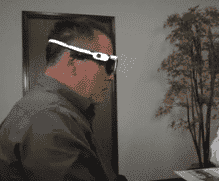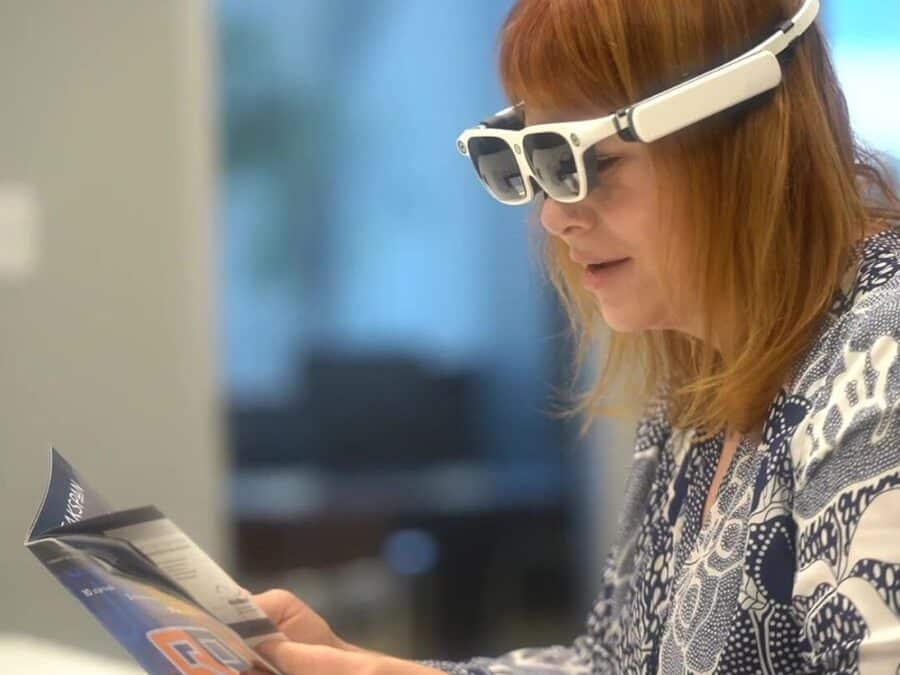Get your questions answered about glasses for macular degeneration
Are you considering whether to invest in smart glasses for macular degeneration? In this post we will answer 5 important questions about this technology. If you have other questions we haven’t addressed here, please leave a comment and we’ll do our best to provide you with the information you need.
- Who can benefit from glasses for macular degeneration?
- What are people saying about these types of smart glasses?
- When and where can you use them?
- Why buy glasses for macular degeneration from AdaptiVision?
- How much do they cost? Is it worth the investment?

Who can benefit from low vision wearable technology?
Experts in the low vision technology space tend to agree that wearable technology is becoming smaller, more sophisticated, and yet, easier to use. With these improvements, smart glasses are reading a wider audience. They are no longer only for the tech-savvy crowd, but can be used by anyone, regardless of age or technical know-how. The devices themselves are intuitive, and come with free, personalized training to help you master the technology at your own pace.
If you are suffering from central vision loss due to macular degeneration, you can likely benefit from wearable technology such as the eSight 4 or the EYE3 by Eyedaptic.
What are people saying about these glasses?
Many low vision users are finding renewed independence and better quality-of-life with their smart glasses. Here is a sampling of reviews on the eSight4 and EYE3 glasses for macular degeneration. Some of the benefits include ease-of-use, visual clarity, and the ability to read, see detail, and interact with others.

“The physical design of the hardware may be one of my favorite designs of a wearable device so far.”
— Sam Seavey, The Blind Life, on the eSight 4

“Without [eSight] everything is fuzzy and I cannot recognize people until I’m a foot away. With eSight, even not zoomed in things are crisp and clear. With the zoom feature, I can read menus on a restaurants wall, supermarket signs and even recognize my husband when he is at the other end of the aisle. eSight has given me the precious gift of sight.”
— Judy U.

“Visual clarity is the most notable change in the upgrade to eSight 4. eSight 4 offers dramatically improved screen resolution, vibrant and crystal clear colors, and exceptional auto-focus capabilities. When you look at things, the view is projected clearly, immediately.”
— Roger Deo, eSight wearer since 2016

“It’s completely live in time when you’re walking. There is no lag.”
— Casey Greer, How Casey Sees It, on the eSight 4

“I was able to see detail on my husband and kids’ faces that I haven’t seen in 15 years.”
“There were less gaps in interactions with my children. Less gaps in me understanding what was going on around me. I feel like I would pay the cost for a device like this.”
— Leah Fanning, Ability Mom of 2, on the eSight 4

“This is amazing. I haven’t read a newspaper or magazine in quite some time, maybe several years. I mean I can actually read this magazine. If this is what I’m going to get with these glasses I would actually start subscribing to newspapers again… I can read everything on the page.”
— Sam Newman, EYE3 User

“It’s almost as good as it used to be when I had perfect vision. I’m not being slowed down… and Eyedaptic has given me that gift in letting me live my life to the fullest.”
— Brian, Eyedaptic user

“Patients often use multiple low vision devices for daily needs and this hands-free, wearable product combines many of those into just one device.”
— Rebecca Kammer, OD, PhD & Low Vision Specialist, on the EYE3
When and where can you use smart glasses for macular degeneration?
As the technology improves, so does the hardware. Glasses are now more comfortable and suitable for many hours of use, even up to all-day, without interruption. They are wireless, hands-free, and come with easy-swap rechargeable batteries, so you can move about freely. And, they can be worn both indoors and out, adjusting automatically to your lighting environment. So you can wear them for your daily routines, at home and on the move.
In this video review, mother / son team ATSpear conduct a variety of tests on the eSight 4, reflecting typical daily usage in the kitchen, while using a cell phone, reading print material, looking at the board in a classroom, and watching TV.
Why buy glasses for macular degeneration from AdaptiVision?
We know you have many options for purchasing assistive technology like smart glasses. Having been in the field for over 25 years, we recognize that one of the most important factors sought out by low vision customers is excellent customer service and support. That is why we are committed to providing personalized service with every sale. As a small, family-run business, our personal approach is what sets us apart.
If you choose to purchase smart glasses from us, you will receive the following benefits:
- Free, personalized product training, customized to help you meet your goals
- Free, expert tech support
- Free shipping
- Our satisfaction guarantee
- A one-year manufacturer’s warranty
We only offer products that we believe in, products that we believe will help our customers achieve greater independence. And if we feel a solution is NOT right for you, we will tell you.
How much do these glasses cost? Is it worth the investment?

Here is our pricing on the two products discussed in this post:
- eSight 4 (Price: $6,900)
- EYE3 by Eyedaptic (Price: $5,950)
It is hard to put a price on independence! Still, we understand that purchasing smart glasses is a significant financial investment, and that they may not be right for everyone. To understand whether it is worth the cost, we highly recommend that you set up a free low vision consultation with us. That way, we can discuss your goals and whether or not smart glasses are the right fit. Click on the button below to start.
Request a MeetingAuthor Information
By Bethany Wyshak. Reviewed by Stuart Flom.














Can I use this item while driving.
No, these glasses should not be used for driving.
Do any of insurance companies help with this cost to help the cost be more affordable? Usually you are disabled on a fixed income because your not able to work.
We would love to see insurance companies start to cover these types of devices. Unfortunately, that is not the reality in the US right now. We hope to see progress made in this area in the near future. We also hope that more people with disabilities are able to join the workforce as companies focus more on equity & inclusion. It is important that people with disabilities are empowered to speak up to their local legislators about the insurance coverage issue. And to speak up to employers about accommodations.
Thanks for joining the conversation and highlighting these topics.